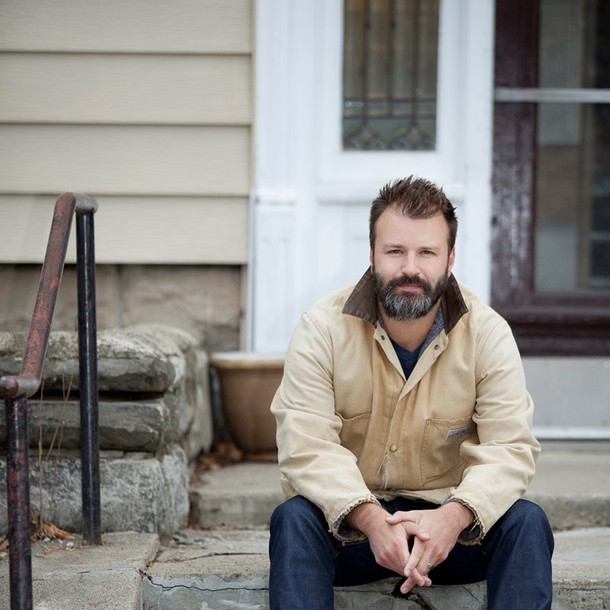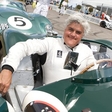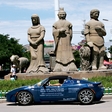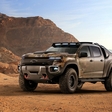
That year's model was notorious for its tragic Achilles heel: poorly designed side-mounted gasoline tanks that exploded when T-boned. After two years of driving this truck, the floorboards were so rusty, so corroded, that I could literally watch the road rush by beneath me. In summer, this was almost refreshing. In winter, I covered the holes with cardboard to keep out the cold and road-slush. I called this truck The Beast. Sadly, it died not long into our relationship. I loved that truck like a mangy old dog.
For the first time in about ten years (for a few years I drove a trusty and loyal little Toyota truck), I'm driving another pickup truck, this one inherited from my grandfather. It is a much nicer vehicle – a 2006 GMC Sierra with extended cab and a huge V8 engine. The interior smells of my Grandpa's bar soap, chainsaw oil, and sawdust, and the driver side rear quarter panel of the truck sports two small dents (my Grandpa's vision and eye-to-hand coordination began to fail him as he grew older). But overall, this truck is, as we say in America, a beaut. 9000 miles on the odometer and a long life to live: hauling firewood and brush, field-stones, camping equipment and banging down backroads with me behind the wheel.
The truth is, I love driving pickup trucks. More than fast cars, gigantic lumbering SUVS, dull family sedans, or dreaded mini-vans.
I suspect that most European readers of this essay will not have ever driven a pickup truck, and this is understandable: narrow roads, tighter urban street patterns, stricter fuel efficiency standards... the list goes on and on. And, unlike America's utterly backward approach to mass transit, high-speed rail, and environmental conservation, progressive European environmental policies don't exactly jibe with pickup trucks and their generally dismal mpg.
So I do understand when there exists a disconnect between Europeans and the United States when it comes to the American love-affair with pickup trucks.
But for many of us, for me and my neighbors in rural Wisconsin, trucks are first and foremost a practical choice. My neighbor Kyle, for example, tends to a buffalo herd and, in wintertime, you can see him out in the snow-cloaked and corn-stubbled field, driving his pickup truck, its bed full of square bales of hay. Or my father-in-law, Jim, working in the apple orchards not far from my house, the bed of his truck full of crates of Braeburns, Cortlands, and Honeycrisp apples. One of my childhood best friends, Novak, is a stone mason and his battered old pickup truck looks like he's thrown a thousand rocks at its abused sidewalls.
Practicality aside, driving a pickup truck has certain aesthetic benefits. It feels, in so many ways, like the 20th or 21st century American horse. Inside a pickup truck, my body relaxes, my left elbow naturally settles into its nook, resting on a rolled-down window. My right hand steers casually, as if I were holding a set of reins, and passing one of my neighbors on the hilly backcountry roads that define this part of Wisconsin, I nod and raise two or three fingers in passing, cool as can be. Even country and western music sounds better inside a truck, some old Merle Haggard tune that celebrates broken hearts, empty checking accounts and, of course, old pickup trucks.
Between the fall of 2010 and the spring of 2012, I drove between Arden Hills, Minnesota and Iowa City, Iowa once a week, a round-trip of just less than 600 miles and about nine hours of drive time. Most of the route was on Interstate 35, a huge jugular of a highway that cuts America in two, running north to south all the way from northern Minnesota down to the Mexican border, and almost parallel with the Mississippi. The section of I-35 that I drove regularly was limitless flat fields of corn, former prairie that is so flat we often joke that in Iowa, if a person stares hard enough, they can see the back of their own head.
It is important for me to clarify that, between Arden Hills and Iowa City, there is no passenger train line, no direct bus route, and airplane fare is outrageously expensive.
The only choice is driving. And when you spend four and half hours driving seventy-five miles per hour through a landscape utterly bereft of topography, what you begin to prioritize in a vehicle is not fuel efficiency, but frankly, comfort. You're sitting for almost five hours. What I wanted most in a vehicle was a quiet cab, a good sound system, and the ability to deal with some truly harrowing road conditions (a blizzard in early 2011 dropped about 15 inches of snow combined with 50-60 mph winds – imagine that tempest rushing across a prairie at your car!)
American political and consumer decisions can be head-scratchingly backward at times, I admit. Why, as Americans, don't we demand better mass transit or high-speed rail? I really don't understand. What we are left with, then, is the reality of travel in a vast, vast country where a trip to the grocery store (or even a gas station) for a gallon of milk or a dozen eggs is a fifteen-mile drive. Where parents spend entire weekends shuttling children hundreds of miles for soccer tournaments. Faced with this reality, would you rather be packed into a small, fuel efficient two-door automobile? Or would you choose something different, more comfortable, perhaps?
You never forget your first love, and mine was that broken-down, janky, 1981 Custom Deluxe pickup truck, the one that promised to explode and cremate my corpse should we ever get violently side-swiped. But my new-old truck reminds me of why I fell in love in the first place, almost twenty years ago. The steering wheel feels loose, somehow, and our progress on any given road, no matter its paving, is a pleasant floating sensation, almost like sailing over America. I fill the bed of my truck with meaningful tools or lumber, and when Johnny Cash rumbles over the radio-waves it feels like the pickup truck is something akin to a national vehicle, this emblem of everything rugged and blue-collar about America.
It just feels right. Like being in love.

Nickolas Butler is the internationally bestselling author of the novel Shotgun Lovesongs and a collection of short stories entitled, Beneath the Bonfire. His second novel, The Faithlessness of Men, will be published in early 2017. He lives in rural Wisconsin with his wife and two children.



